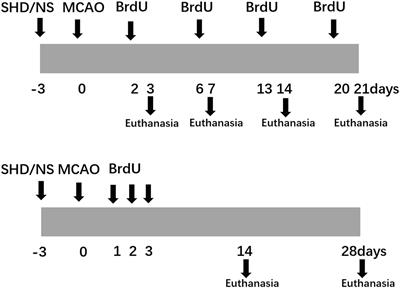
Methods: The male Sprague-Dawley rats (body weight, 250–280 g; age, 7–8 weeks) were randomly divided into sham group, CIR group, and SHD group and were further divided into subgroups according to different time points at 6 h, 1, 3, 7, 14, 21, and 28 d, respectively. The SHD group received intragastric administration of SHD at 10 g kg−1 d−1. The focal CIR models were induced by middle cerebral artery occlusion according to Longa’s method, while sham group had the same operation without suture insertion. Neurological deficit score (NDS) was evaluated using the Longa’s scale. BrdU, doublecortin (DCX), and glial fibrillary acidic protein (GFAP) were used to label proliferation, migration, and differentiation of nerve cells before being observed by immunofluorescence. The expression of reelin, total tau (t-tau), and phosphorylated tau (p-tau) were evaluated by western blot and RT-qPCR.
Results: SHD can significantly improve NDS at 1, 3, 7, and 14 d (p < 0.05), increase the number of BrdU positive and BrdU/DCX positive cells in subventricular zone at 3, 7, and 14 d (p < 0.05), upregulate BrdU/GFAP positive cells in the ischemic penumbra at 28 d after CIR (p < 0.05), and reduce p-tau level at 1, 3, 7, and 14 d (p < 0.05). There was no significant difference on reelin and t-tau level between three groups at each time points after CIR.
Conclusions: SHD exerts neuroprotection probably by regulating p-tau level and promoting the proliferation, migration, and differentiation of endogenous neural stem cells, accompanying with neurobehavioral recovery.

Δεν υπάρχουν σχόλια:
Δημοσίευση σχολίου